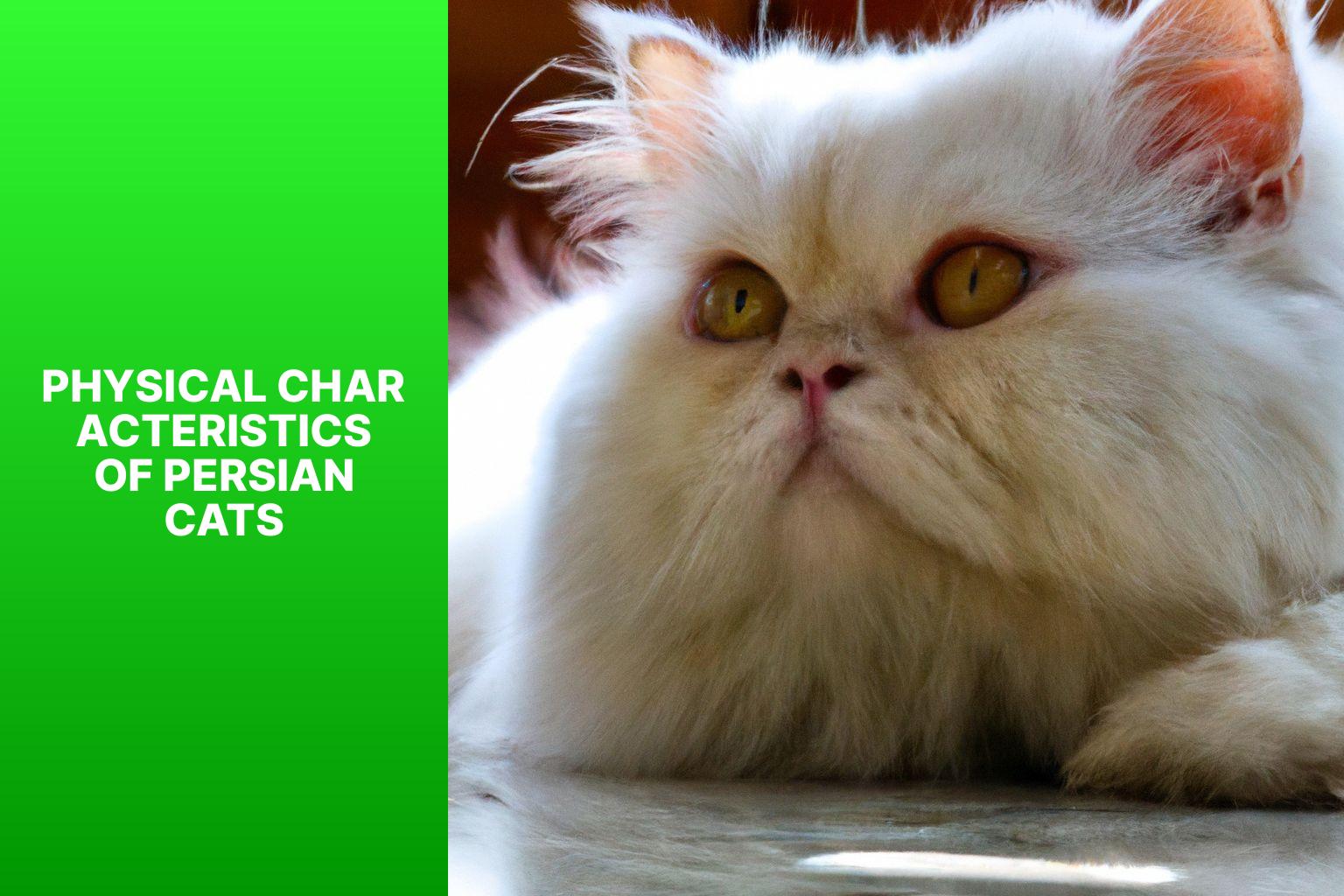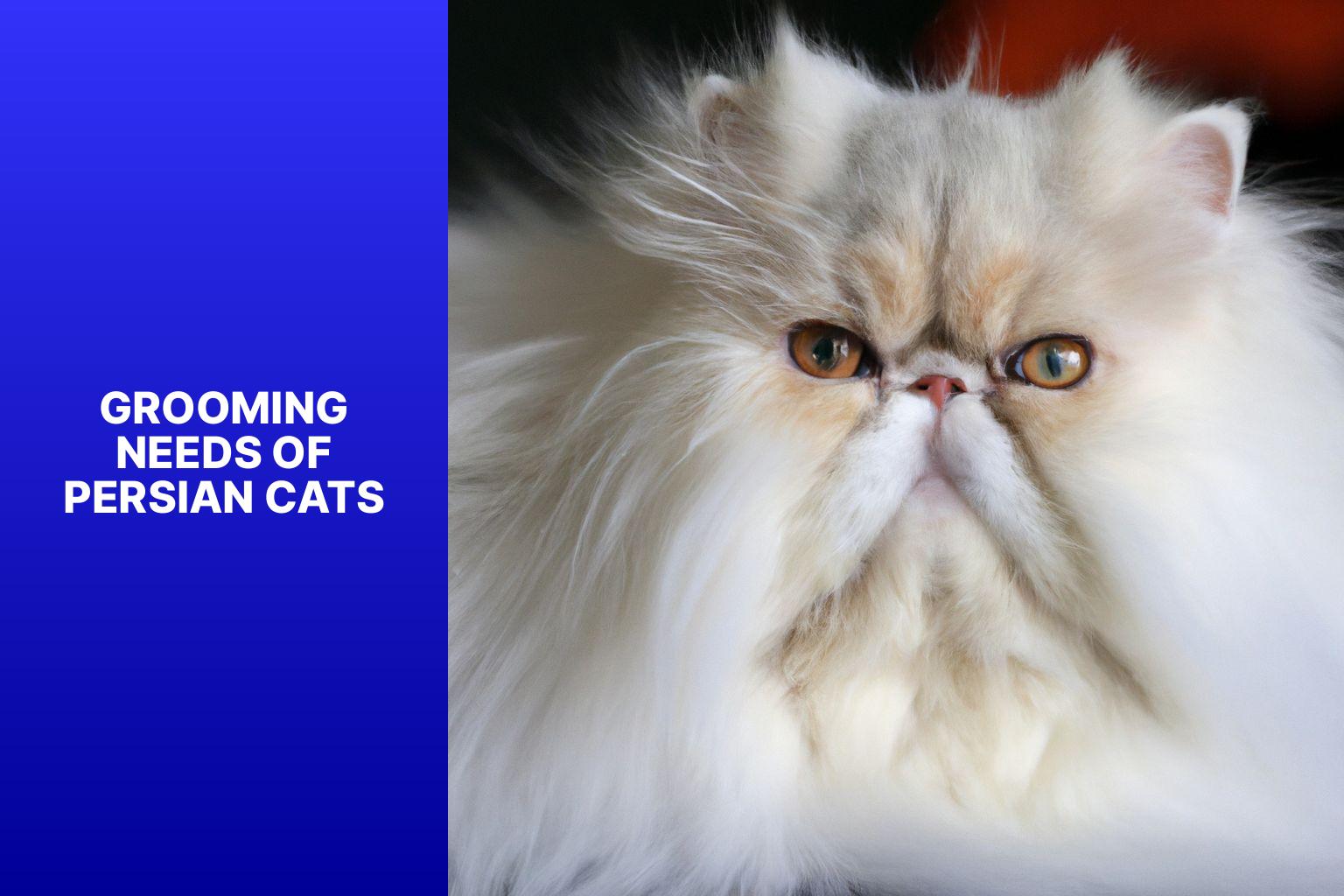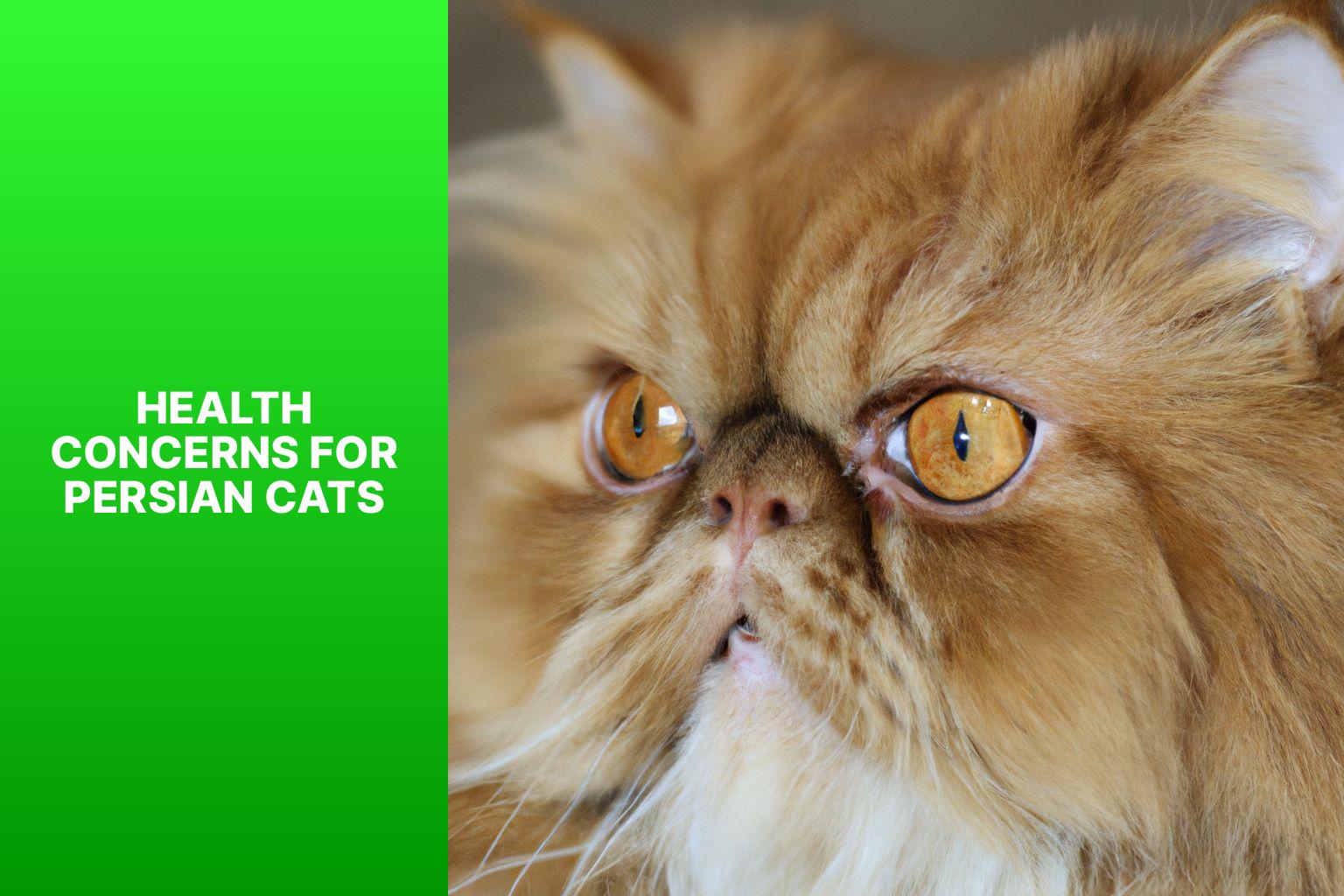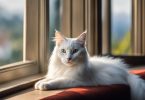The Persian cat is a breed known for its distinctive physical characteristics, charming personality, and unique grooming needs. Understanding what a Persian cat looks like is essential for those interested in owning or learning about this beloved feline companion. Persian cats are known for their luxurious and dense coats, stocky body structure, and distinct facial features.
Persian cats have long, thick, and lustrous coats that come in a wide variety of colors and patterns. Their fur is soft to the touch and requires regular grooming to prevent matting.
Persian cats have a sturdy and muscular body with a short neck, broad chest, and a round, wide head. They have short, strong legs and large paws. Their overall physique exudes elegance and grace.
Perhaps the most distinguishing feature of Persian cats is their unique facial structure. They have large, expressive eyes that can be various shades of blue, green, or copper. Their flat face is accompanied by a short, broad nose with a break, giving them a “smushed” appearance. Persian cats also have small, rounded ears and a sweet, gentle expression.
Persian cats come in a wide range of colors and patterns, making each cat unique and visually stunning.
Solid-colored Persian cats have a coat that is uniform in color throughout. Common solid colors include white, black, cream, blue, red, and various shades of brown.
Tabby patterns are characterized by swirls, stripes, or spots on the cat’s coat. Persian cats can have tabby patterns in various colors, including brown, silver, and blue.
Persian cats can also have bi-color or calico patterns, which involve patches of two or more colors on their coats. Bi-color patterns typically include white plus another color, while calico patterns consist of three colors, including white, black, and orange.
Persian cats have unique grooming needs due to their long and dense coats.
Regular brushing is necessary to prevent tangles and matting in the Persian cat’s coat. Daily brushing helps maintain the coat’s health and beauty.
Because of their facial structure, Persian cats are prone to eye discharge. Regular cleaning of the eyes and facial folds is crucial to prevent infection and maintain hygiene.
Trimming the cat’s nails and cleaning their ears on a regular basis are essential parts of Persian cat grooming to avoid overgrowth and ear infections.
Persian cats are known for their gentle and calm temperament.
Persian cats are generally quiet, affectionate, and love to curl up for a nap. They enjoy a peaceful and relaxed environment and make great companions for individuals or families.
Persian cats generally get along well with other pets if introduced and socialized properly. They prefer a harmonious and calm atmosphere.
Persian cats are prone to certain health issues that potential owners should be aware of. These include respiratory problems, eye conditions, and dental issues. Regular veterinary check-ups are crucial to monitor their health and address any potential concerns.
To ensure the well-being of a Persian cat, provide them with a balanced and nutritious diet, maintain their grooming routine, create a safe and comfortable living environment, and offer plenty of love and affection.
Understanding the physical characteristics, grooming needs, personality traits, and potential health concerns of Persian cats is essential for anyone interested in welcoming these beautiful creatures into their homes. With proper care and attention, Persian cats make loving and loyal companions.
Key takeaway:
- Persian cats have a distinct physical appearance: They have a long, thick coat, a sturdy body structure, and unique facial features such as a round face and small ears.
- Persian cats come in various colors and patterns: They can be solid in color, have tabby patterns, or exhibit bi-color and calico patterns.
- Grooming is essential for Persian cats: Their coat requires regular care, their eyes and face need special attention, and their nails and ears should be regularly maintained.
- Persian cats have specific personality traits: They are known for their calm temperament and can get along well with other pets.
- Health concerns exist for Persian cats: They are prone to certain health issues that require proper care and medical attention.
- Tips for owning a Persian cat: Prospective owners should be aware of their grooming needs, provide a suitable environment, and address any health concerns promptly.
Physical Characteristics of Persian Cats
Photo Credits: Www.Catcornerblog.Com by Adam Thomas
Persian cats are known for their distinct physical characteristics that make them instantly recognizable. In this section, we will uncover the unique features that define the physical appearance of Persian cats. From their luxurious coats to their elegant body structure and adorable facial features, we will explore what sets Persian cats apart. Get ready to dive into the fascinating world of these exquisite felines and marvel at their captivating physical traits.
Coat
The Persian cat’s coat is a distinctive feature, characterized by its long, dense, and luxurious fur that gives the cat a regal and elegant appearance. The coat consists of a fine, silky outer layer and a thick, plush undercoat.
Persian cats display a variety of coat colors and patterns, including solid colors, tabby patterns, and bi-color and calico patterns.
To maintain a Persian cat’s coat, regular grooming is necessary. Due to the long hair’s propensity to mat and tangle, daily brushing is important to keep it clean and knot-free. This routine helps prevent discomfort and reduces the risk of hairballs. Occasionally, bathing may also be required to preserve the coat’s optimal appearance.
One personal experience that beautifully showcases the magnificence of a Persian cat’s coat is my adoption of Bella, a stunning silver-colored Persian cat with delicate tabby markings. Bella’s fur was incredibly soft and fluffy, reminiscent of the sensation of running your fingers through a cloud. Her coat was her pride, and she would confidently strut around the house, displaying her regal nature. Grooming Bella’s long, silky hair became a calming ritual, and she would happily purr throughout the process. Her coat exemplified her majestic and regal nature, earning her the title of the queen of our household.
Body Structure
The body structure of Persian cats is characterized by distinct features. Persian cats have a compact and muscular body with a rounded chest and solid build. They also have short, strong legs that contribute to their stocky physique. Persian cats have a broad chest, large round heads, and a short and thick neck. Their dense and plush coat enhances their body structure, adding to their overall volume and elegance.
Persian cats have a unique body structure that sets them apart from other cat breeds. Their round and stocky build, along with their distinct facial features, contribute to their charm and appeal.
Persian cats originated in Persia (modern-day Iran) and have a long and rich history. They were highly prized by royalty and nobility in ancient Persia due to their distinct body structure and luxurious coat. In the 17th century, Persian cats were introduced to Europe and gained popularity for their beauty and elegance. They have since become one of the most beloved and cherished cat breeds worldwide.
Facial Features
Persian cats are known for their unique facial features, including a flat face, large round eyes, small round ears, short broad nose, pronounced cheeks, and soft fluffy whiskers. These distinctive characteristics greatly contribute to the charm and appeal of Persian cats.
Colors and Patterns of Persian Cats
Persian cats are a true masterpiece when it comes to colors and patterns. From solid colors to tabby patterns, and bi-color to calico patterns, these feline beauties offer a mesmerizing spectrum of hues and designs. Prepare to be amazed as we delve into the stunning world of Persian cat aesthetics, exploring the enchanting variations that make them so unique. Get ready to discover the captivating colors and patterns that grace these regal creatures, as we embark on a delightful journey into the realm of Persian cat enchantment.
Solid Colors
Persian cats come in a variety of solid colors, including white, black, red, cream, blue, and chocolate. These colors are evenly distributed across the cat’s entire coat, giving them a dense and lustrous appearance.
The color of a Persian cat’s eyes can complement its coat color. For example, white Persian cats often have blue or odd-eyed eyes, while black Persian cats typically have copper or gold eyes.
To enhance your Persian cat’s coat color, provide proper grooming, including routine brushing to maintain shine and prevent matting. Regular checkups with a veterinarian are also important for your cat’s overall health and well-being. When choosing grooming products, opt for gentle and hypoallergenic options to avoid skin issues. Remember to cater to your Persian cat’s specific needs and create a loving and caring environment.
Tabby Patterns
Tabby patterns in Persian cats are highly sought after by cat enthusiasts due to their uniqueness and appeal. These patterns are characterized by distinct markings on the cat’s coat, creating an attractive and one-of-a-kind look. The tabby patterns include stripes, spots, and swirls, which contribute to the overall charm of the cat.
In order to showcase the various tabby patterns found in Persian cats, a visual representation is provided in the following table:
| Pattern | Description |
|---|---|
| Mackerel Tabby | This pattern consists of vertical stripes resembling a fish skeleton. |
| Classic Tabby | Known as the “blotched” tabby, it features large swirling patterns on the sides. |
| Spotted Tabby | Similar to the patterns seen on leopards or cheetahs, this tabby has scattered spots across its coat. |
| Ticked Tabby | Each hair on this tabby has light and dark rings, creating a banded appearance. |
When considering a Persian cat with tabby patterns, it is important to ensure that the markings are clear and well-defined. The pattern should be evenly distributed throughout the coat, and the colors should be vibrant. By selecting a cat that matches your preferences and lifestyle, you can ensure a perfect fit.
Whether you are drawn to the classic tabby with its swirls or the exotic spotted tabby with its leopard-like spots, Persian cats with tabby patterns make a delightful addition to any household. Their unique coat patterns add charm and captivate all who see them.
Bi-Color and Calico Patterns
| Pattern Type | Description |
| Bi-Color | A Bi-Color Persian cat has a solid coat color with white patches on the body. The white patches are usually on the chest, paws, face, and tail. The amount of white can vary. |
| Calico | A Calico Persian cat has a coat with three dominant colors – white, black, and orange. The colors are in distinct patches all over the body. The orange patches are sometimes called “red” in the cat fancy. Calico patterns can vary in intensity and size. |
Both Bi-Color and Calico patterns are popular in Persian cats because of their unique and striking appearances. These patterns show the beautiful color variations in Persian cats. It’s important to note that the Bi-Color and Calico patterns can vary from cat to cat, with some having larger or more defined patches.
When choosing a Persian cat with a Bi-Color or Calico pattern, consider personal preferences and the cat’s markings. Each cat will have its own distinct pattern that adds to its beauty and charm. Proper grooming and care will keep the coat lustrous and healthy.
Remember, these patterns are just some of the intriguing possibilities in the coat colors and patterns of Persian cats. Each cat is unique, and their patterns contribute to their individuality and appeal.
Grooming Needs of Persian Cats
Photo Credits: Www.Catcornerblog.Com by Justin Wilson
Persian cats are known for their luxurious, long coats and captivating appearance. But have you ever wondered about the specific grooming needs of these regal felines? In this section, we’ll dive into the essential areas of grooming for Persian cats. From coat care to eye and facial care, and even nail and ear care, we’ll explore the various aspects of grooming that contribute to keeping these elegant cats looking their best. Get ready to discover the secrets to maintaining the beauty and health of your Persian companion!
Coat Care
When taking care of a Persian cat’s coat, consider the following factors:
– Regular brushing: Use a brush designed for long hair cats to remove loose hairs and prevent mats and tangles.
– Bathing: Keep the coat clean by regularly bathing the cat with cat-friendly shampoo and thorough rinsing.
– Trimming: Trim the hair around the rear end and eyes to prevent issues like feces getting stuck and eye irritation.
– Eye care: Gently clean the cat’s eyes with a damp cotton ball to remove discharge. Consult a vet for signs of infection.
– Diet: Provide a balanced diet with high-quality cat food for a healthy coat. Consult a vet for specific recommendations.
– Professional grooming: Consider taking the cat to a groomer for a thorough groom every few months.
Following these coat care tips will help keep a Persian cat’s coat healthy, beautiful, and free from tangles and mats.
Eye and Facial Care
Eye and facial care is crucial for maintaining the health and beauty of Persian cats. Here are some important aspects to consider:
– Clean the eyes: Persian cats are prone to tear staining due to their large eyes. Gently wipe their eyes daily with a clean cloth or specialized pet wipes to remove any discharge or tear stains and prevent matting and infection.
– Check for eye problems: Persian cats are prone to cherry eye, corneal ulcers, and eyelid problems. Regularly inspect their eyes for redness, swelling, or discharge. Consult a veterinarian if you notice any abnormalities.
– Facial hygiene: Persian cats have a flat face with folds and creases that can accumulate dirt and bacteria. Regularly wipe the facial area with a damp cloth, paying attention to the folds around the nose, muzzle, and mouth.
– Prevent dental issues: Brush their teeth regularly using a cat-friendly toothbrush and toothpaste to maintain overall health and promote fresh breath.
– Trim facial hair: Regularly trim the long facial hair to prevent it from accumulating food particles and causing discomfort.
By following these practices, you can ensure that your Persian cat’s eyes and facial area remain clean, healthy, and free from any potential issues.
Nail and Ear Care
When it comes to nail and ear care for a Persian cat, there are some important factors to keep in mind:
- Nail care: It is crucial to regularly trim the nails of your Persian cat in order to prevent any discomfort or injury. Be sure to use cat nail clippers to carefully trim the tips of their nails, being cautious not to cut into the sensitive quick. If you are unsure or uncomfortable with doing this yourself, it is advisable to seek assistance from a professional groomer or veterinarian.
- Ear care: Persian cats are more prone to experiencing ear infections. It is, therefore, essential to regularly check their ears for any signs of redness, swelling, discharge, or a foul odor. Gently clean their ears using an ear cleaning solution approved by a veterinarian, along with a cotton ball or pad. Avoid using cotton swabs or inserting anything deep into their ear canal to prevent any injury. If you notice any concerning symptoms or if your cat appears to be in discomfort, consult a veterinarian for further guidance.
A true story serves as a reminder of the significance of nail and ear care for Persian cats. A negligent pet owner allowed their cat’s nails to grow excessively, leading to pain and difficulty in walking. The cat developed a severe ear infection that went unnoticed. Thankfully, the owner learned from their mistakes and sought appropriate grooming and medical treatment. This experience highlights the importance of regular grooming for the overall health and well-being of a Persian cat.
Personality Traits of Persian Cats
Persian cats are more than just their beautiful appearance. When it comes to their personality traits, it’s an intriguing mix. In this section, we’ll dive into their temperament and their behavior with other pets. From their calm and gentle nature to their interactions with furry companions, get ready to discover what makes Persian cats truly special. So, let’s unravel the captivating world of Persian cat personalities and explore their unique traits.
Temperament
The temperament of Persian cats can vary, but they generally exhibit several traits. Persian cats are known for being gentle, making them ideal companions for individuals seeking a tranquil setting. They are quite affectionate towards their owners and enjoy receiving affection and human companionship. Although Persian cats are typically calm, they can also be playful and enjoy engaging in gentle play and interacting with toys. When considering the temperament of a Persian cat, it is essential to spend time with the specific cat to understand its unique personality before making the decision to adopt. If you desire a quiet and affectionate companion, a Persian cat would be an excellent choice. Providing them with ample affection and creating a calm environment will contribute to their overall well-being.
Behavior with Other Pets
When it comes to behavior with other pets, Persian cats can vary depending on their personalities and experiences. Here are some key things to consider:
- Socialization: Persian cats need proper socialization from an early age to develop positive behaviors towards other pets. Expose them to different animals and supervise interactions to encourage good behavior.
- Temperament: Persian cats are generally calm and laid-back, making them more tolerant and accepting of other pets. They are less confrontational and may avoid conflict.
- Introductions: Introduce Persian cats to other pets gradually and in a controlled environment. Start with separate spaces and slowly allow them to interact under supervision. This gives them time to adjust and establish boundaries.
- Hierarchy: Persian cats may establish their own hierarchy in a multi-pet household. Monitor and ensure that all pets feel safe and comfortable. Provide separate resources such as food bowls, litter boxes, and resting areas to avoid conflicts.
- Positive Reinforcement: Reward good behavior and provide praise to shape positive interactions between Persian cats and other pets. This encourages them to associate pleasant experiences with their furry companions.
Pro-tip: If you have concerns about introducing a Persian cat to other pets, consult a professional animal behaviorist or veterinarian for guidance and support.
Health Concerns for Persian Cats
Photo Credits: Www.Catcornerblog.Com by Russell Perez
Persian cats are known to have several health concerns, including respiratory issues, eye problems, and skin conditions. Due to their flat faces and shortened nasal passages, they commonly experience respiratory issues that can make breathing difficult and increase the likelihood of respiratory infections. Persian cats are prone to eye problems such as excessive tearing, eye infections, and corneal ulcers. To prevent and manage these issues, regular eye exams and proper eye care are essential. Another concern for Persian cats is their skin health. Their long and dense coat requires regular grooming to avoid matting and skin irritations. They are also susceptible to skin allergies and dermatitis, which may necessitate dietary adjustments or medication. Therefore, it is crucial to schedule regular veterinary check-ups to ensure the well-being of your Persian cat. Providing them with a clean and stress-free environment, as well as a balanced diet, can significantly improve their overall health. Maintaining proper dental hygiene is important in preventing periodontal disease. By being aware of these health concerns and taking proactive measures, you can ensure a happy and healthy life for your beloved Persian cat.
Tips for Owning a Persian Cat
Tips for Owning a Persian Cat
– Regular grooming: Persian cats need daily brushing to prevent matting and tangling. Use a high-quality brush for their fur.
– Eye care: Persians often have eye discharge and tear staining. Clean their eyes regularly with a damp cloth and consult a vet for persistent issues.
– Indoor living: Keep Persian cats indoors to protect their delicate coat from dirt and parasites. Provide toys and scratching posts for a safe and stimulating environment.
– Diet and hydration: Give your Persian cat a balanced diet with plenty of protein. Make sure they always have fresh, clean water.
One day, I noticed my Persian cat, Snowball, pawing at her eyes more than usual. I took her to the vet who informed me about common eye issues in Persians. I learned how to clean Snowball’s eyes properly and started caring for them diligently. Gradually, the issues improved. Owning a Persian cat demands patience, dedication, and regular grooming and medical care. Stay alert for signs of discomfort and seek professional help when needed. Despite the extra care they need, Persian cats offer love and companionship that makes it all worthwhile.
Some Facts About What Does a Persian Cat Look Like:
- ✅ Persian cats have a round head with large, round eyes and a flat face. (Source: Hill’s Pet)
- ✅ They have a short and thick body with thick legs, a short neck, and small ears. (Source: Hill’s Pet)
- ✅ The Persian cat’s coat is thick, full, and long, and should be lustrous and glossy. (Source: Hill’s Pet)
- ✅ They come in various colors and patterns, such as white, red, cream, black, blue, chocolate, and more. (Source: Hill’s Pet)
- ✅ Persian cats are commonly found and can appear larger than they actually are due to their thick fur. (Source: Hill’s Pet)








